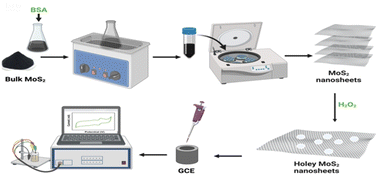Holey MoS2-based electrochemical sensors for simultaneous dopamine and uric acid detection
Abstract
In this study, two-dimensional holey MoS2 (h-MoS2) nanosheets were used to develop electrochemical sensors for simultaneous detection of dopamine (DA) and uric acid (UA). The holes were created on MoS2 layers using hydrogen peroxide (H2O2) in the presence of Bovine Serum Albumin (BSA). h-MoS2 was characterized by transmission electron microscopy (TEM), field emission scanning electron microscopy (FE-SEM), X-ray photoelectron spectroscopy (XPS), X-ray diffraction (XRD), Raman spectroscopy, dynamic light scattering (DLS), and ultraviolet-visible spectroscopy (UV-vis). Electrochemical dopamine and uric acid sensors were prepared by drop-casting h-MoS2 on a glassy carbon electrode (GCE). The electroanalytical performance of the sensors was evaluated using cyclic voltammetry (CV), differential pulse voltammetry (DPV), and electrochemical impedance spectroscopy (EIS) methods. The sensors revealed linear ranges between 50–1200 μM and 200–7000 μM with a limit of detection (LOD) of 4.18 μM and 5.62 μM for DA and UA, respectively. Furthermore, the h-MoS2-based electrochemical sensors showed high stability, sensitivity, and selectivity. The reliability of the sensors was elucidated in human serum. Recoveries ranging between 100.35% and 102.48% were calculated from real sample experiments.



 Please wait while we load your content...
Please wait while we load your content...